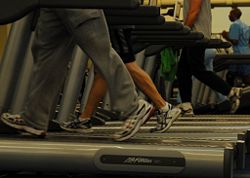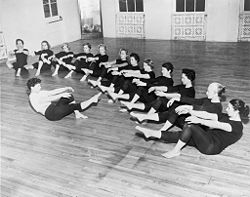Physical fitness
Physical fitness is used in the context of two meanings: general fitness (a state of health and well-being) and specific fitness (the ability to perform specific sports or occupational skills). Fitness can be further subdivided into five categories: cardiovascular endurance, muscular strength, muscular endurance, flexibility, and body composition. The criteria for physical fitness has also expanded to include the capacity to meet physical demands in an emergency situation.
Physical fitness is the capacity of the heart, blood vessels, lungs, and muscles to function at optimum efficiency. In previous years, fitness was defined as the capacity to carry out the day’s activities without undue fatigue. However, with increased leisure time, and changes in lifestyles wrought by the industrial revolution, which took a large proportion of the population away from farm life and into more urban areas, this definition is no longer considered comprehensive enough.
The definition for physical fitness is now defined as the body’s ability to function efficiently and effectively in work and leisure activities, not only at a set point in time, but at various ages and stages within a person's life cycle. The key is in finding optimum health within the limits of one's lifestyle in order to be able to resist hypokinetic diseases. (Those conditions that occur as a result of a sedentary lifestyle. Examples would include obesity and complications arising from obesity such as diabetes.)
Many health professionals today; including doctors, nurses,occupational therapists and physical therapists would agree that a wholistic approach that allows for a person to make decisions and be proactive in regard to his or her own health works best.
History of fitness
[1]Greeks, 18 and 19 cent. feats of endurance value of physical
[2]industrial rev. sedantry lifestyle, unsafe [3] fast food,
Kennedy, fitness - a national concern [4]
General fitness
To allow for closer evaluation, physical fitness is often divided into the following categories:
1. Cardiovascular endurance: This is the ability of the body to deliver oxygen and nutrients to tissues and to remove wastes over sustained periods of time. CE can be improved through aerobic exercise; those performed at a moderate level of intensity over a relatively long period of time such as running or playing tennis.
2. Muscular strength & endurance: Strength deals with the ability of the muscle to exert force for a brief time period, while endurance is the ability of a muscle, or group of muscles, to sustain repeated contractions or to continue to apply force against an inert object.
3. Flexibility: This denotes the ability to move joints and use muscles through their full range of motion.
4. Body composition: Composition refers to the body in terms of lean mass (muscle, bone, vital tissue, and organs) and fat mass. An optimal ratio of fat to lean mass can be determined by a person's BMI (Body/Mass index) which is a more accurate method of determining whether a person's weight is healthy in relationship to their particular physique. Performing the right set of exercises can help people convert body fat by increasing muscle mass. [1]
General physical fitness can also include - but is not limited to - all of the following: accuracy,agility, balance, aerobic exercise, coordination, and joint range of motion. Especially in the case of athletics terms like Power, Speed, Stamina and Strength are appropriate.

Many sources also cite mental and emotional health as an important part of overall fitness. This is sometimes presented as a triangle made up of three sub-sections, which represent physical, emotional, and mental fitness. The "ideal triangle" is balanced in all three areas. Like the nutrition pyramid designed for healthy eating, the "triangle" is in alignment with practitioners today that wish to address a more wholistic approach towards health and aging.
Specific fitness requirements
Specific or task-oriented fitness is a person's ability to perform at a specific activity with a reasonable efficiency, for example, in sports or in military service. Specific training can prepare either an athlete or a worker in their particular field or sport.
Examples of atheletic training would be: traing for a 400m sprint - in which case a runner performs at ultimate speed throughout a short distance, the athlete must be trained to run anaerobically throughout the race; In the case of a marathan, which covers a long distance, the athlete must be trained to work aerobically and endurance must be increased to the maximum.
Firefighters and police officers must undergo regular Fitness testing to determine if they are capable of the physically demanding tasks required for their jobs. In the Scouting programs of some countries, students can earn fitness badges, such as the Physical Fitness Badge which is earned in the United States by both boy and girl scouts.
Family fitness
[5] YMCA, physical exercise through family activities, dental, vision and physical check ups, preventive care, vitamins, immunizations
How a nation can help: school lunches
Fitness for kids
PE Class, sports, exergaming, family pet,Boys and Girls Club
Fitness for adults
Prevention: chiropractic, annual physical check up, monitoring of BP and cholestoral levels. alternative therapies
Seniors and physical fitness
Lifestyle adjustments, change in metabolism, medical tests as necessary, fitness center or gym membership (health club, personal trainer
Notes
- ↑ Hardcastle, Jonathon. The Importance of Physical Fitness Ezinearticles.com. Retrieved June 15, 2008.
ReferencesISBN links support NWE through referral fees
- What's Really Making America's Children Fat? in TIME Magazine (Special Health issue) June 23, 2008.
- Kolata, Gina Bari. 2003. Ultimate fitness: the quest for truth about exercise and health. New York: Farrar, Straus and Giroux. ISBN 0374204772
- Bogert, L. Jean, George M. Briggs, and Doris Howes Calloway. 1973. Nutrition and physical fitness. Philadelphia: Saunders. ISBN 0721618170
- Sharkey, Brian J. 2002. Fitness and health. Champaign, IL: Human Kinetics. ISBN 0736039716
- Greenberg, Jerrold S., and David Pargman. 1986. Physical fitness: a wellness approach. Englewood Cliffs, N.J.: Prentice Hall ISBN 013668856X
- Halper, Marilyn Snyder, and Ira Neiger. 1981. Physical Fitness. A Preventive medicine Institute/Strang Clinic health action plan. New York: Holt, Rinehart & Winston. ISBN 0030482917
- Ettinger, Walter H., Brenda S. Wright, and Steven N. Blair. 2006. Fitness after 50. Champaign, IL: Human Kinetics. ISBN 0736044132
External links
- HealthierUS.gov Official website. Retrieved May 23, 2008.
- President's Council on Physical Fitness. Retrieved May 23, 2008.
- What is Physical Fitness?
- AHA Exercise and Fitness Guidelines
- The Importance of Physical Fitness
- Fitness at Any Age
- Physical Fitness Articles
- Fitness after 50
- Girls and Physical Fitness
- Physical Fitness Guide for Kids
Credits
New World Encyclopedia writers and editors rewrote and completed the Wikipedia article in accordance with New World Encyclopedia standards. This article abides by terms of the Creative Commons CC-by-sa 3.0 License (CC-by-sa), which may be used and disseminated with proper attribution. Credit is due under the terms of this license that can reference both the New World Encyclopedia contributors and the selfless volunteer contributors of the Wikimedia Foundation. To cite this article click here for a list of acceptable citing formats.The history of earlier contributions by wikipedians is accessible to researchers here:
The history of this article since it was imported to New World Encyclopedia:
Note: Some restrictions may apply to use of individual images which are separately licensed.
